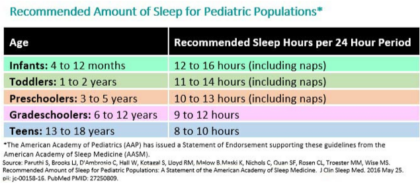As parents, we know that sleep is essential, and it is a necessary part of our daily lives and, especially, our children’s daily lives. Just like diet and exercise, the amount of sleep one gets can influence how well we and our children function in school, at home, at work, and with others. There are two types of sleep cycles that humans go through at different times during their asleep time. Non-Rapid Eye Movement (NREM), or deep sleep, makes up 75% of our sleep. Rapid Eye Movement (REM), or light sleep, makes up 25% of our sleep (Lissienko, 2014). When children experience poor sleep quality and/or short sleep durations, these can contribute to inadequate sleeping behavior. As infants, sleep is critical for aiding in healthy brain development, building memory, developing social skills, and fostering emotional growth (Dutil, Walsh et al, 2018). Children will spend 40% of their childhood asleep (The National Sleep Foundation). Therefore, parents and caregivers should establish healthy sleep habits in infants to help prevent long-term health problems. Some health problems that are associated with poor sleep in children and adolescents include obesity, impaired memory and attention, and poor academic performance in school-age children (El-Sheikh, Buckhalt, Cummings, & Keller, 2007; Meltzer, & Mindell, 2009).
The following bulleted items list a few indicators, from the National Sleep Foundation, that give some examples of characteristics your child may exhibit if he or she is not getting enough quality sleep:
Young Children (Babies, Toddlers)
- Is cranky regularly;
- Displays fidgety, antsy, or hyperactive behavior;
- Has trouble sharing, taking turns;
- Is not talkative, does not communicate;
- Wakes up groggy; falls asleep after being awakened and needs to be awakened again.
Children in Elementary School
- Is Hyperactive;
- Falls asleep at inappropriate times;
- Needs to be awakened in the morning, sometimes multiple times;
- Lacks interest, alertness, motivation, and/or an attention span;
- Seems drowsy at school or at home during homework time;
- Exhibits academic struggles;
- Has trouble falling asleep.
Preteens/Teens
- Is chronically late for school;
- Experiences mood swings;
- Has trouble concentrating;
- Feels unmotivated;
- Acts irritable in the early afternoon;
- Falls asleep easily during the day;
- Has academic troubles;
- Is hyperactive or aggressive;
- Acts nervously.
Please view the following chart that lists recommended hours of sleep based on your child’s age to see if your child is getting enough hours of sleep.

If you believe your child is having sleep troubles or suffering from other medical conditions that may be impacting his or her sleep quality, consider seeking professional help.
Additional Resources
References
Dutil, C., Walsh, J. J., Featherstone, R. B., Gunnell, K. E., Tremblay, M. S., Gruber, R., … Chaput, J. (2018). Influence of sleep on developing brain functions and structures in children and adolescents: A systematic review. Sleep Medicine Reviews, 42, 184-201. doi:10.1016/j.smrv.2018.08.003
El‐Sheikh, M., Buckhalt, J. A., Mark Cummings, E., & Keller, P. (2007). Sleep disruptions and emotional insecurity are pathways of risk for children. Journal of Child Psychology and Psychiatry, 48(1), 88-96. doi:10.1111/j.1469-7610.2006.01604.x
Lissienko, K. (2014, October 23). Normal sleep patterns. Retrieved from https://www.kidshealth.org.nz/normal-sleep-patterns
National Sleep Foundation. (n.d.). Children & sleep. Retrieved from https://www.sleepfoundation.org/articles/children-and-sleep
